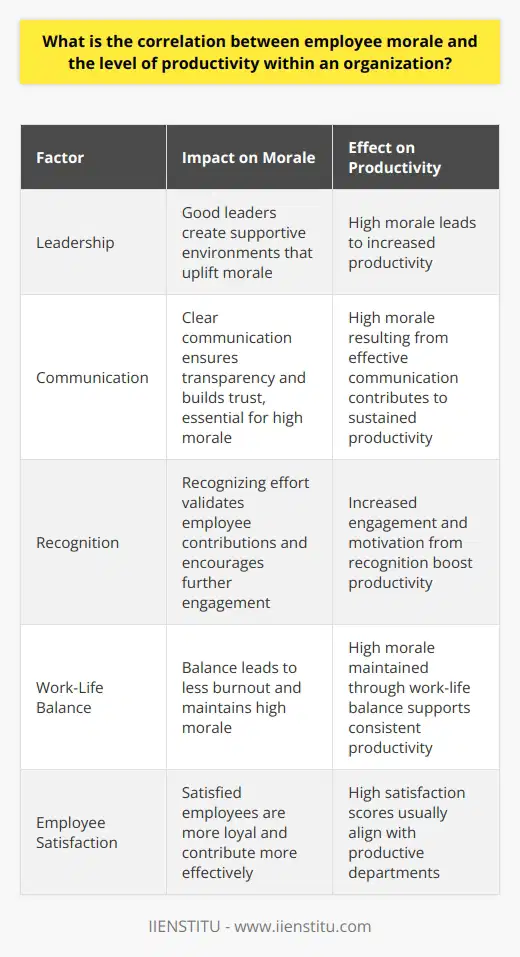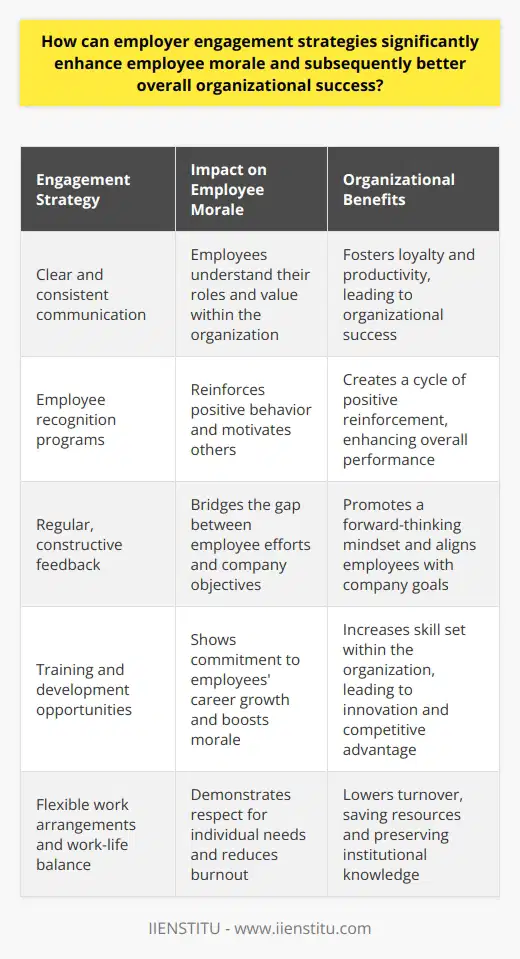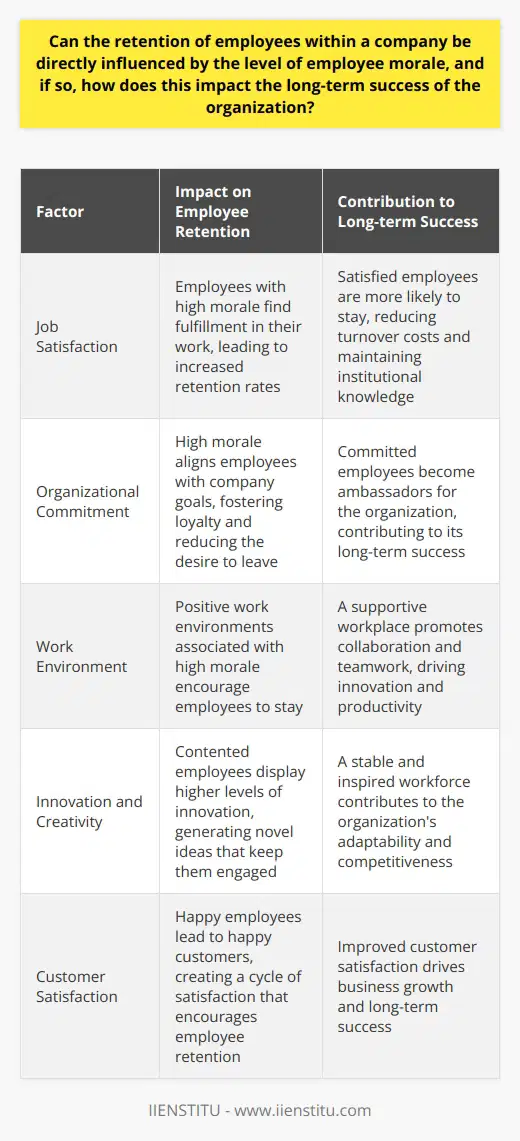
Employee morale can often be the barometer of a company's health. As a crucial determinant of organizational success, it can significantly sway the company's trajectory. With companies vying for sustainability and growth in competitive markets, understanding the cause and effect relationship between employee morale and business success has never been more important.
This article seeks to delve into the nuances of employee morale, exploring its impacts, pertinent strategies for improvement, and how its measurement can be a catalyst for organizational development.
Understanding employee morale
Employee morale encompasses the overall outlook, attitude, satisfaction, and confidence that employees feel at work. It is more than the sum of its parts, affecting each employee and, collectively, the performance of an organization.
Discussion of different perspectives on employee morale
From an employee's perspective, morale is pivotal to their engagement with their work. When morale is high, employees tend to have a sense of purpose and commitment to their roles. They are not only more productive but also advocates for their company's brand, driving a positive workplace culture. Conversely, from management's perspective, employee morale is a driver for organizational efficiency, growth, and talent retention. Low morale can lead to a host of problems, from poor customer service to increased absenteeism and a higher turnover rate.
Factors influencing morale
Numerous factors contribute to shaping the morale of employees. Working conditions that ensure safety, comfort, and a balanced work-life integration are fundamental. Organizational culture also plays a pivotal role in shaping morale; it is the social soil in which employees' attitudes either flourish or wither. The leadership style adopted by managers can severely influence morale, with transformational leadership often cited as the most conducive to high morale. Recognition and rewards signify the value an organization places on its employees, while opportunities for professional growth, such as certificate courses online or hr certificate course participation, exemplify an investment in the employees' future.
Importance of High Employee Morale
High morale is not simply a benefit but a necessity for a thriving workplace. When employees feel positive about their environment and contributions, they exceed their own performance expectations, contributing to a successful and productive team.
Benefits Administration: Comprehensive Insights and Best Practices
Variable Pay: An In-depth Look at Modern Compensation Strategies
Positive impacts of high employee morale
Enhanced employee productivity is one of the most significant benefits of high morale. Employees are more motivated and willing to put in the effort to achieve business objectives. Additionally, companies with high employee morale often report a decreased turnover rate, which is indispensable as recruiting and training new talent can be expensive and time-consuming. Notable examples of successful businesses with high employee morale are perennially present in 'best places to work' rankings, showcasing the linkage between employee contentment and business triumph.
Negative effects of low employee morale
Similarly, low employee morale is often a precursor to reduced productivity. Tasks take longer to complete, and the quality of work suffers. This can spiral into a high turnover rate, as high-performing employees seek out better environments and recognition for their efforts. A glance at businesses negatively impacted by low employee morale reveals the somber repercussions, such as faltering customer loyalty and ultimately, a damaged brand reputation.
Strategies for Boosting Employee Morale
A proactive approach towards fostering high morale is fundamental for an organization's leadership. Implementing well-thought-out strategies aimed at morale improvement can avert the risks associated with dissatisfaction and foster a culture of contentment and productivity.
Fostering open and honest communication
Open channels of communication instill a sense of belonging and respect among employees. Transparent dialogues concerning company goals, performance feedback, and addressing concerns contribute positively to employee sentiments.
Offering regular recognitions and rewards
Regular recognitions and rewards signal to employees that their contributions are valued. This can be materialized through performance bonuses, time off awards, or even career advancement opportunities such as sponsoring an hr certificate course.
Investing in employee growth and development
Commitment to employee growth and development is depicted through mentorship programs, access to certificate courses online, and clear career trajectory paths. When employees see investment in their professional capabilities, it accelerates their commitment and enthusiasm for their work.
Measuring Employee Morale
To ensure that strategies are effective, organizations must possess the ability to measure and track the progress of employee morale accurately.
Tools and techniques for measuring morale
Commonly deployed tools for this purpose include employee surveys that can gauge the collective mood and pinpoint areas of concern. One-on-one check-ins provide a personal touch and can unearth issues that may be missed in a survey. Lastly, observational methods can be reflective of the spontaneous interactions and overall atmosphere within the workforce.
Interpreting and analyzing results
Drawing actionable insights from these metrics requires a keen interpretive approach. Trends should be identified, and the feedback should form the basis of targeted improvements. Recognizing patterns can help preempt issues before they affect morale and business outcomes.
Case Studies
Analysis of companies that have successfully boosted employee morale
Examining case studies of companies that have successfully navigated the challenge of boosting morale offers valuable lessons. These companies often exhibit a strategic blend of methods for improving morale and maintaining it at favorable levels.
Lessons learned from these case studies
The lessons drawn emphasize the importance of a tailored approach, wherein understanding the unique composition and needs of an organization's workforce is pivotal. Recognition, communication, and investment in growth are recurring themes seen in such success stories.
Recap of the role of high employee morale for business success
In conclusion, the quantitative and qualitative impact of high employee morale is indisputable. It is the lubricant that keeps the gears of an organization running smoothly, directly linking to productivity, retention, and ultimately, the bottom line.
Final thoughts on the importance of prioritizing and maintaining healthy employee morale.
Employee morale is not a static element within an organization; it requires continuous nurturing. It is imperative for management to remain committed to fostering an environment where morale can thrive, ensuring the long-term success and vitality of the organization. Efforts to sustain high morale are a testament to a company's recognition of its most valuable asset: its people.
Frequently Asked Questions
What is the correlation between employee morale and the level of productivity within an organization?
Understanding Employee Morale
Employee morale embodies the overall outlook, attitude, satisfaction, and confidence that employees feel at work. High morale operates as a performance catalyst. It boosts enthusiasm and fosters an environment conducive to high productivity.
Link to Productivity
Productivity signifies the output of an organization. It hinges on employee effectiveness and efficiency. Morale directly influences these factors. Elevated morale often correlates with heightened productivity. Low morale may cause a downturn in employee output.
Examining the Correlation
Studies confirm morale's impact on productivity. Positive work environments nurture high morale. This, in turn, results in better work quality. Conversely, negative atmospheres can lower morale. This often leads to reduced productivity.
Morale's Effect on Work Attitude
Motivated employees tend to work harder. Their high morale translates to a diligent work ethic. Morale shapes commitment. It aligns employee goals with those of the organization.
The Role of Satisfaction
Satisfaction is a morale component. Satisfied employees deliver better results. They show greater care in their tasks. Satisfaction also fosters loyalty. Loyal employees contribute more effectively.
Confidence and Its Influence
Confidence springs from high morale. Confident employees are more inventive. They handle complex tasks with assurance. Confidence allows them to solve problems efficiently. Efficient problem-solving increases productivity.
Factors that Affect Employee Morale
Numerous elements can sway morale.
- Leadership plays a pivotal role. Good leaders can uplift morale. They create supportive environments. Support breeds contentment among the workforce.
- Communication is foundational. Clear communication ensures transparency. Transparency builds trust. Trust is essential for high morale.
- Recognition fuels morale. Recognizing effort validates employee contributions. Validation encourages further engagement and productivity.
- Work-Life Balance is crucial. Balance leads to less burnout. Less burnout maintains high morale and productivity.
Measuring the Impact
Quantifying morale and productivity can be tricky. Yet, a number of indicators help.
- Turnover Rates can reflect morale. Low turnover often means high morale. High morale contributes to sustained productivity.
- Employee Surveys offer direct insight. They can gauge morale and its effects. High satisfaction scores usually align with productive departments.
- Productivity Metrics can reveal correlations. An uptick in output may suggest improved morale.
The link between employee morale and productivity is evident. High morale fosters a vibrant, productive workforce. Neglecting morale can lead to losses in productivity. Organizations should strive to maintain high employee morale. This strategy can ensure sustained productivity and organizational success.

How can employer engagement strategies significantly enhance employee morale and subsequently better overall organizational success?
The Necessity of Employer Engagement
Employers must recognize the direct link between their engagement strategies and employee morale. High morale can propel entire organizations toward unparalleled success. Engagement signals to employees that the company values their contributions and well-being. Such realization fosters loyalty and productivity, elements core to organizational triumph.
Engagement: A Catalyst for Morale
Employer engagement anchors a thriving workplace culture. This engagement begins with clear and consistent communication. Employees need to understand both their roles and their value. The strategy should include employee recognition as well. Acknowledging achievements reinforces positive behavior and motivates others. Employers can implement peer recognition programs, creating a cycle of positive reinforcement.
Strategy and Implementation
Regular feedback is critical. It bridges the gap between employee efforts and company objectives. Real-time feedback allows for quick course corrections. Thus the alignment with company goals becomes efficient. Feedback should be constructive and solution-focused. It promotes a forward-thinking mindset.
Employers also need to offer development opportunities. Training, upskilling, and cross-skilling show a commitment to employees' career growth. Such initiatives not only boost morale. They also increase the skill set within the organization, leading to innovation and competitive advantage.
Work-Life Balance
Work-life balance is fundamental. Balance is no longer a luxury but an expectation. Employers must provide flexibility where possible. Flexible working hours, the possibility of remote work, and sufficient vacation time can all contribute. These practices show respect for the individual needs of employees. They also reduce burnout and turnover.
The Benefits of High Morale
Teams with high morale perform better. They display increased productivity and enhanced creativity. Collaboration soars when individuals feel valued. Customer satisfaction often follows suit, as happy employees tend to provide better service.
Lower turnover is another benefit of high morale. Recruiting and training new staff can be costly. Retaining employees saves resources and preserves institutional knowledge. It sparks a virtuous cycle. Employee satisfaction leads to better service, which in turn fosters customer loyalty. This loyalty enhances organizational success.
In Summary
Employers' engagement strategies undoubtedly affect bottom-line results. Improved morale from these strategies can have tangible benefits. These range from productivity to innovation to customer satisfaction. The connection between employee well-being and organizational success is indisputable. Engaged employers can not only expect better outcomes from their teams. They can also look forward to a more robust, successful organization overall.

Can the retention of employees within a company be directly influenced by the level of employee morale, and if so, how does this impact the long-term success of the organization?
Employee morale stands as a cornerstone in the edifice of organizational success. It serves not only as a barometer for the general state of the workforce but also as a predictive index for the frequency of staff turnover. The retention of employees within a company can indeed be directly influenced by the extent of employee morale. How does this unfold?
Understanding Employee Morale
Employee morale measures the overall outlook, satisfaction, and confidence that employees feel at work. It is the esprit de corps that propels the company forward. High morale translates into a workforce that is engaged, committed, and loyal.
The Direct Influence on Employee Retention
There exists a causal link between morale and retention. Employees with high morale are more likely to remain with their current employer. Neglecting morale fuels dissatisfaction, propelling employees to seek alternative employment. Here are key factors at play:
Job Satisfaction
Employees find fulfillment in their work when morale is high. They believe in their roles and the impact thereof. This satisfaction breeds a strong retention rate.
Organizational Commitment
Investment in the company's goals aligns with high morale. Employees become ambassadors for the dream. Their loyalty tempers the urge to leave.
Work Environment
High morale often means a positive work environment. Colleagues become supportive peers. The workplace becomes a second home.
The Impact on Long-term Success
The long-term success of an organization intertwines with its ability to retain competent employees. Morale stands as the fulcrum, leveraging various aspects of organizational health.
Innovation and Creativity
Contented employees display higher levels of innovation. Their creativity flourishes. Novel ideas spring from a stable and inspired workforce.
Productivity
High morale often equates to high productivity. Employees work with vigor and purpose. Output surges, and so does quality.
Reduce Costs
Employee turnover incurs costs. High morale minimizes these expenditures. Recruitment budgets diminish as does the loss of tacit knowledge.
Customer Satisfaction
The ripple effect of high employee morale touches customers. Happy employees lead to happy customers. The cycle of satisfaction perpetuates itself.
- High morale drives strong employee retention.
- Employee retention fosters long-term organizational success.
To encapsulate, the vitality of a company lies not just in its strategic direction or market prowess, but equally in its human capital — the employees. It is the fabric of morale that weaves a loyal and steadfast workforce. In nurturing this fabric, companies maintain a competitive advantage. Employees stay, grow, and contribute to the overarching objectives. The morale of the workforce thus becomes synonymous with the very pulse of the organization, dictating its rhythm and future prosperity.



